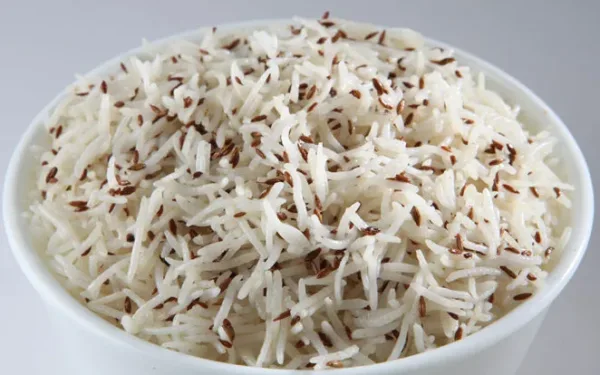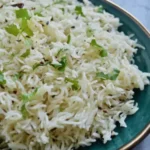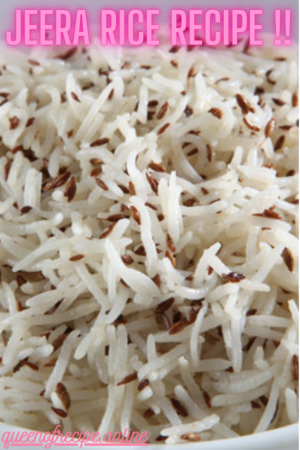Table of Contents
About Jeera Rice
Jeera Rice is a staple food that has been consumed by people around the world for thousands of times. It’s one of the most important cereal crops and is a salutary chief in numerous societies, particularly in Asia, Africa, and Latin America. Rice is a protean grain that can be prepared in colorful ways, and it’s a good source of carbohydrates, vitamins, and minerals.
Jeera rice, also known as cumin rice, is a popular and aromatic Indian rice dish. It is made by cooking basmati rice with cumin seeds, ghee or oil, and other spices, resulting in a flavorful and fragrant side dish. It is commonly served in Indian cuisine as a accompaniment to various curries, dals, and other main dishes. Its simplicity and versatility make it a beloved staple in Indian households and a delightful addition to any meal. Whether enjoyed on its own or paired with other dishes, it offers a delightful blend of spices and textures that entices the taste buds.
Ingredients for making Jeera Rice
- 1 mug basmati rice
- 2 mugs water
- 2 soupspoons ghee or oil painting
- 1 tablespoon cumin seeds
- 1 cinnamon stick
- 2- 3 cardamom capsules
- 2- 3 cloves
- swab to taste
Instructions for making Jeera Rice
- Wash the basmati rice in cold water until the water runs clear, also soak it in water for 20- 30 twinkles.
- Toast a saucepan over medium heat, add the ghee or oil painting, and allow it to heat up.
- Add the cumin seeds to the visage and stir them until they start to sizzle and come ambrosial.
- Add the cinnamon stick, cardamom capsules, and cloves to the visage and stir them for a many seconds until they release their aroma.
- Drain the water from the soaked rice and add it to the visage. Stir gently to fleece the rice with the spices.
- Add 2 mugs of water and swab to taste. Stir well and bring the admixture to a pustule.
- Reduce the heat to low, cover the visage with a tight- befitting lid, and poach for 18- 20 twinkles or until the rice is cooked through and all the water has been absorbed.
- Remove the visage from the heat and let it sit, covered, for 5 twinkles.
- Fluff the rice with a chopstick and serve hot.
This rice can be served as a side dish to colorful Indian dal, Chane or enjoyed on its own with raita or yogurt.
Nutritional Value of Jeera Rice
Jeera rice is a popular Indian dish made by cooking rice with cumin seeds and other sweet spices. The nutritive value of it can vary depending on the type of rice used, the cuisine system, and the quantum of spices added. Then’s the approximate nutritive value of these rice made with white basmati rice and 1 teaspoon of ghee.
- Calories 200
- Carbohydrates 37g
- Protein 4g
- Fat 4g
- Fiber 1g
- Sodium 300 mg
- Iron 2 mg
- Calcium 15 mg
- Potassium 80 mg
- Magnesium 15 mg
This rice is a good source of carbohydrates and provides some protein, fat, and fiber. The cumin seeds used in this rice are also known to have some health benefits, similar as abetting digestion and reducing inflammation. Still, this rice made with a lot of ghee or oil painting can be high in calories and impregnated fat, so it’s important to consume it in temperance as part of a balanced diet.


Health Benefits
Eating it can provide several health benefits due to the ingredients used in its preparation. Here are some potential health benefits of consuming it:
- Digestive Aid: Jeera (cumin) is known for its digestive properties. It helps stimulate the production of enzymes, aiding in the breakdown of food and improving digestion. Consuming this rice can assist in alleviating digestive discomfort and promoting overall digestive health.
- Nutrient-Rich: Basmati rice, commonly used in this rice, is a good source of carbohydrates and provides essential nutrients such as fiber, B vitamins, and minerals like magnesium and manganese. These nutrients support energy production, brain function, and overall well-being.
- Anti-inflammatory Effects: Cumin, the key spice in this rice, possesses anti-inflammatory properties. It contains compounds that may help reduce inflammation in the body, potentially benefiting conditions such as arthritis and other inflammatory disorders.
- Antioxidant Activity: Cumin is also rich in antioxidants, which help protect the body against damage from free radicals. These antioxidants contribute to overall cellular health and may play a role in reducing the risk of chronic diseases.
- Flavorful Alternative: It can be a healthier alternative to other flavored rice dishes that may contain higher levels of fats, oils, or sodium. By incorporating fragrant cumin seeds, minimal oil or ghee, and a balanced spice blend, this rice offers a flavorful option while keeping the overall dish relatively light.
It’s important to note that while this rice can offer health benefits, the overall nutritional value depends on the ingredients used and portion sizes. Pairing the rice with a balanced meal that includes protein, vegetables, and other nutrients further enhances its nutritional profile.
Tips and Tricks
Jeera rice, also known as cumin rice, is a flavorful Indian rice dish made with basmati rice and cumin seeds. Here are some tips and tricks to make delicious jeera rice:
- Use good quality basmati rice: For the best results, use long-grain basmati rice. The fragrance and texture of basmati rice complement the cumin seeds beautifully.
- Rinse the rice: Rinse the basmati rice in cold water 2-3 times until the water runs clear. This removes excess starch and prevents the rice from turning sticky while cooking.
- Soak the rice: Soak the rinsed rice in water for 20-30 minutes before cooking. This helps the rice cook evenly and results in fluffy grains.
- Proper water-to-rice ratio: The ideal water-to-rice ratio for jeera rice is 1.5 to 2 cups of water for 1 cup of rice. Adjust the water amount based on the brand of rice and personal preference. Using too much water can make the rice mushy.
- Toast the cumin seeds: In a separate pan, dry roast the cumin seeds for a minute or two until they release their aroma. This enhances the flavor of the cumin in the final dish.
- Use ghee or oil: You can prepare jeera rice with ghee (clarified butter) or oil. Ghee adds a rich flavor, while oil keeps the dish vegan. Heat the ghee or oil in a pan before adding the cumin seeds.
- Sauté the cumin seeds: Add the cumin seeds to the hot ghee or oil and sauté them for a minute until they sizzle and become fragrant. Be careful not to burn them.
- Cook the rice on low heat: Once the cumin seeds are sautéed, drain the soaked rice and add it to the pan. Gently sauté the rice with the cumin seeds for a minute. Then, add the water, salt, and any optional spices you prefer (such as whole spices like bay leaves, cinnamon, or cardamom). Bring the water to a boil, then reduce the heat to low, cover the pan with a lid, and let the rice simmer until cooked.
- Fluff the rice: Once the rice is cooked, let it rest for a few minutes. Then, use a fork to fluff the rice gently. This separates the grains and prevents them from clumping together.
- Garnish: For an extra touch of flavor and visual appeal, garnish the jeera rice with fresh coriander leaves (cilantro) before serving.
Jeera rice is a versatile side dish that pairs well with a variety of Indian curries and gravies. It’s simple to make and adds a delightful aroma and taste to your meal. Enjoy your jeera rice with your favorite dishes!


Serving Suggestions
Jeera rice, also known as cumin rice, is a flavorful Indian dish made with basmati rice and cumin seeds. Here are some serving suggestions to enjoy with jeera rice:
- Dal (Lentil Curry): Serve jeera rice with a comforting dal, such as dal tadka or dal makhani. The combination of the aromatic rice and lentil curry creates a balanced and satisfying meal.
- Vegetable Curry: Pair jeera rice with a variety of vegetable curries like aloo matar (potato and peas curry), paneer butter masala, or mixed vegetable curry for a wholesome vegetarian meal.
- Raita: Prepare a cooling cucumber or mixed vegetable raita to serve alongside jeera rice. The creamy yogurt-based condiment complements the spices in the rice.
- Papad: Include crispy papadums or poppadoms as a crunchy side to add texture to the meal.
- Pickles: Add some tangy and spicy Indian pickles or mango chutney as a condiment to enhance the flavors of the jeera rice.
- Roasted Vegetables: Roast seasonal vegetables like carrots, bell peppers, and zucchini with Indian spices and serve them with jeera rice for a wholesome and nutritious meal.
- Chutney: Offer a variety of chutneys, such as mint chutney or tamarind chutney, to add a burst of flavor to the rice.
- Yogurt: Serve plain yogurt alongside jeera rice to cool down the palate and balance out the spices.
- Poppadoms or Papadums: Enjoy jeera rice with crispy poppadoms or papadums for a traditional Indian dining experience.
Feel free to mix and match these serving suggestions based on your preferences and the occasion. Jeera rice is a versatile dish that pairs well with a wide range of curries and accompaniments. Enjoy your jeera rice meal!
FAQs
Is Jeera Rice good for stomach?


Yes, jeera rice can be beneficial for the stomach due to the presence of cumin seeds. Cumin has been traditionally used for its digestive properties and is known to aid in relieving digestive discomfort, reducing bloating, and improving overall digestion. The combination of cumin seeds and rice in jeera rice can help soothe the stomach and promote healthy digestion when consumed in moderation and as part of a balanced diet.
Can Jeera Rice leftovers be used to make good Biryani?


Yes, jeera rice leftovers can be repurposed to make a flavorful biryani. The pre-cooked jeera rice can serve as an excellent base for a biryani dish by adding additional spices, vegetables, protein (such as cooked chicken, paneer, or tofu), and garnishes. The flavors from the jeera rice will infuse into the biryani, creating a delicious and aromatic dish that makes good use of leftovers while adding a twist to the meal.
What goes best with Jeera Rice?


Jeera rice pairs well with a variety of Indian dishes. Here are a few options that complement the flavors and textures of jeera rice:
Dal (Lentil Curry): Serve this rice alongside a flavorful dal, such as dal tadka or dal makhani, for a complete and satisfying meal. The combination of the rice and dal provides a balance of protein, carbohydrates, and spices.
Vegetable Curry: Pair jeera rice with a flavorful vegetable curry, such as aloo gobi (potato and cauliflower curry) or palak paneer (spinach and cottage cheese curry). The mild and fragrant rice complements the spiced and aromatic vegetable curries.
Raita: Accompany this rice with a refreshing side of raita, a yogurt-based condiment with added vegetables, such as cucumber, tomato, or boondi. The cool and creamy raita adds a contrasting texture and helps balance the flavors of the rice.
These are just a few examples, and the versatility of jeera rice allows it to be paired with a wide range of curries, dals, and side dishes based on personal preferences and regional cuisine.

